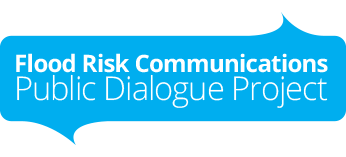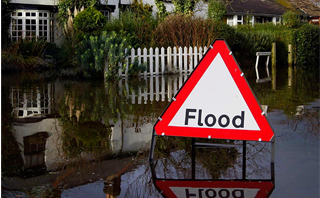Flood risk communications – who does it, what works, and what are the problems?
As part of this project we looked at the existing research on flood risk communications. We also interviewed people from the most important agencies involved in flood risk communications in the UK. This is a very brief summary of our main findings.
Click here to view our full report and full Literature Review.
What is the aim of flood risk communications?
The aim of flood risk communications is to give the public (and communities) clear and practical information so they can either take action to prevent flooding or, if that is not possible, minimise the impact of any flooding that does occur.
When are people likely to hear about flood risk?
There are clear systems for telling people about flooding that is about to happen or is happening. Key organisations like the Environment Agency, the Met Office, the emergency services and the media generally co-ordinate to make sure that people don’t get the wrong message.
When flooding is not imminent, the ways that people learn about it vary widely, for example, when they are moving house, buying house insurance or when people they know have been flooded.
Who communicates flood risk in the UK?
There are a lot of groups involved in communicating flood warnings in the UK including; the Environment Agency, the Met Office, the Flood Forecasting Centre, the emergency services, local authorities, the media and members of the public.
Communications routes
When there is a risk of immediate flooding, the Environment Agency sends out flood warnings to the media, the emergency services and the public.
The public receives these warnings from a variety of different sources including television, local radio, newspapers, social media, the telephone, texts and emails.
People can also get flood risk information from the Environment Agency website, and by registering to receive warnings from Floodline Warnings Direct.
Social media
Social media, such as Twitter, Facebook and Instagram, have created new opportunities for talking about flood risk.
People who use social media can get instant access to flood risk information. People tend to check its credibility because the information comes from a variety of sources. It is also important to remember that many people do not use social media.
What type of communications (are reported to) work when people are at immediate risk of flooding?
- Giving people practical advice.
- Giving people clear, factual information.
Also
- The message must be consistent.
- The tone should be positive rather than negative, encouraging interaction.
- The message must come from a credible source.
- People prefer communications where they have the chance to confirm with and ask questions of the person giving the information.
- Even when people are at risk of immediate flooding they generally check what family, friends or people like themselves are doing, before deciding on what to do themselves.
When people are not in immediate danger of flooding, it is less clear what type of communications work.
However, it is important that flood risk communications clearly outline the responsibilities of everyone involved in flood risk management – agencies and the members of the public – in order to encourage people to think about what they can do for themselves.
What else affects how people respond when they hear they are at risk of flooding?
- The type of flood, for example if the flooding is caused by rainfall or the river bursting its banks, and the speed of the water.
- Social factors, such as class and income.
- Previous experience of flooding.
- The characteristics of the area, for example whether it is urban or rural.
- The type of property they live in, for example by the riverside in single-storey buildings or basements.
- People’s personalities and attitudes to risk.
- Media reporting of flood risk.
- How far people trust the agencies responsible for dealing with flooding to give accurate and useful advice.
Techniques for communicating with people about flooding
Techniques used to communicate about flooding, other than in writing, include using flood maps, games, educational activities, video, and images.
When there is an urgent flood risk, other techniques are used, including police officers knocking on doors, sirens, loudhailers, electronic message boards at roadsides, announcements in public buildings and media announcements.
One future option might be to send automatic alerts to all mobile phones within an at-risk area.
It is very difficult to assess the effectiveness of techniques for communicating risk.
However, it is important that techniques are adapted for each situation, for example, the aims of the communicator and the needs and knowledge of the audience.
Group discussions between local people and experts have been used successfully to develop new ways of talking about flooding. This has increased local knowledge and people’s ability to prepare for the risk of flooding.
Issues for current flood risk communications
While flood risk communication has developed in recent years, government agencies and the public think it could be improved still further.
We should think about the following issues:
- Risk communications could be improved, for example the language and techniques used by government agencies.
- Risk is a difficult concept to explain and understand. Also, different personalities react to risk differently. There are some groups of people who will probably never think about flood risk.
- Relying on people being able to get flood risk information online is a problem as some people do not have internet access and are not IT literate.
- Some groups in society are less likely to receive information about flooding as they are socially isolated, do not watch TV news or use the internet or social media.
- Social media has created a different relationship between the government agencies and members of the public, with the public being more involved in sharing and creating information.
- Getting people and communities involved in talking about flood risk increases people’s understanding of local flood risk, and the preparations they make to protect themselves against flooding.
Preparing for flood risk involves a mental process of:
(1) Recognising that you are at risk and that you need to do something about it (‘facing up to flood risk’).
(2) Exploring what flood risk means for you and your family, and considering the options for dealing with flood risk (for example individual property protection, joining a flood group, signing up for flood warnings, ) and deciding which options are best for you.
This may be where dialogue has a lot to offer.

















